VIP Port Adapter Functions
The stations detect the collision and use backoff algorithms to determine when they should retransmit. Both Ethernet and IEEE 802.3u are broadcast networks, which means that all stations see all transmissions. Each station must examine received frames to determine whether it is the intended destination and, if it is, pass the frame to a higher protocol layer for processing.
Each physical layer protocol has a name that summarizes it characteristics in the format speed/signaling method/segment length where speed is the LAN speed in megabits per second (Mbps), signaling method is the signaling method used (either baseband or broadband), and segment length is typically the maximum length between stations in hundreds of meters. Therefore,
IEEE 802.3u specifies the following different physical layers for
•
•
•
30
